Abstract
BACKGROUND--Adult patients with total correction of tetralogy of Fallot may have poor exercise capacity associated with impaired right heart function and in particular pulmonary regurgitation. The ventilatory responses to exercise were studied in a group of such patients to assess relations between ventilation, exercise capacity, and right ventricular function. METHODS--30 patients (7 female) (aged 27.8 (6.0) years) and 30 (7 female) controls of a similar age range were studied prospectively. All underwent exercise testing with metabolic gas exchange to determine peak oxygen consumption (peak VO2), and (as indices of the ventilatory response) the slope of the relation between both respiratory rate (RR) and ventilation (VE) against carbon dioxide production (VCO2). Patients were studied with pulsed wave Doppler echocardiography to determine pulmonary arterial systolic and diastolic flow characteristics. Patients were defined as having restrictive right ventricular function where diastolic pulmonary forward flow was seen coincident with atrial systole. RESULTS--In the group with tetralogy of Fallot mean (SD) peak VO2 was 35.3 (7.5) ml/kg/min (93.6 (15.3) % of expected for age, weight, height and sex). The RR/VCO2 slope was steeper in the Fallot group (6.8 (2.6) v 9.6 (4.7), P < 0.02). Those with restrictive right ventricles achieved a higher peak VO2 than those without (82.5 (10.1) % v 100.9 (13.8), P < 0.001). In the Fallot group alone, there was an inverse relation between ventilatory response and peak VO2 (RR/VCO2 v peak VO2; r = -0.63, P = 0.003: VE/VCO2 v peak VO2; r = -0.62, P < 0.001). CONCLUSIONS--Many of these patients with repaired tetralogy of Fallot had near normal exercise capacity, but as exercise capacity decreased, the ventilatory response to exercise increased. This was not due to alterations in pulmonary function tests or to the effects of cardiac size causing decreased lung volume. It may be that the increased ventilatory rate at a given level of carbon dioxide production acts as a respiratory pump aiding right ventricular function.
Full text
PDF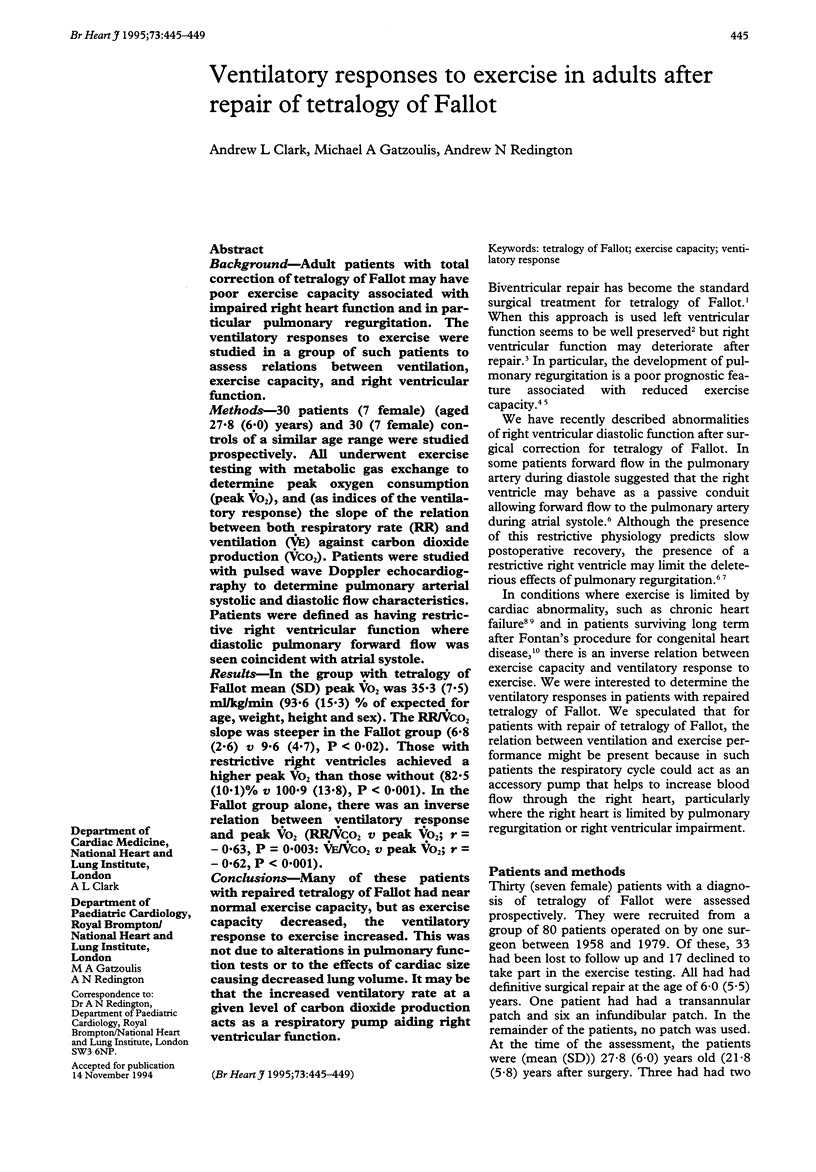
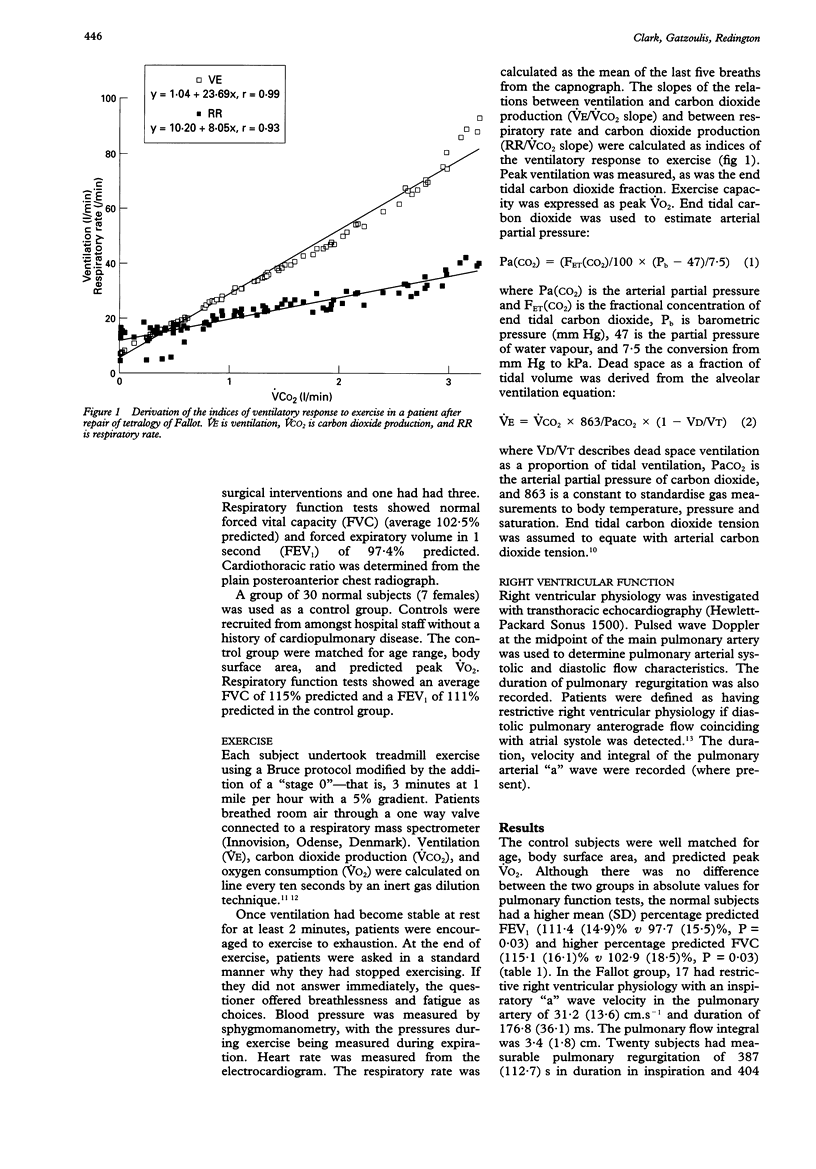
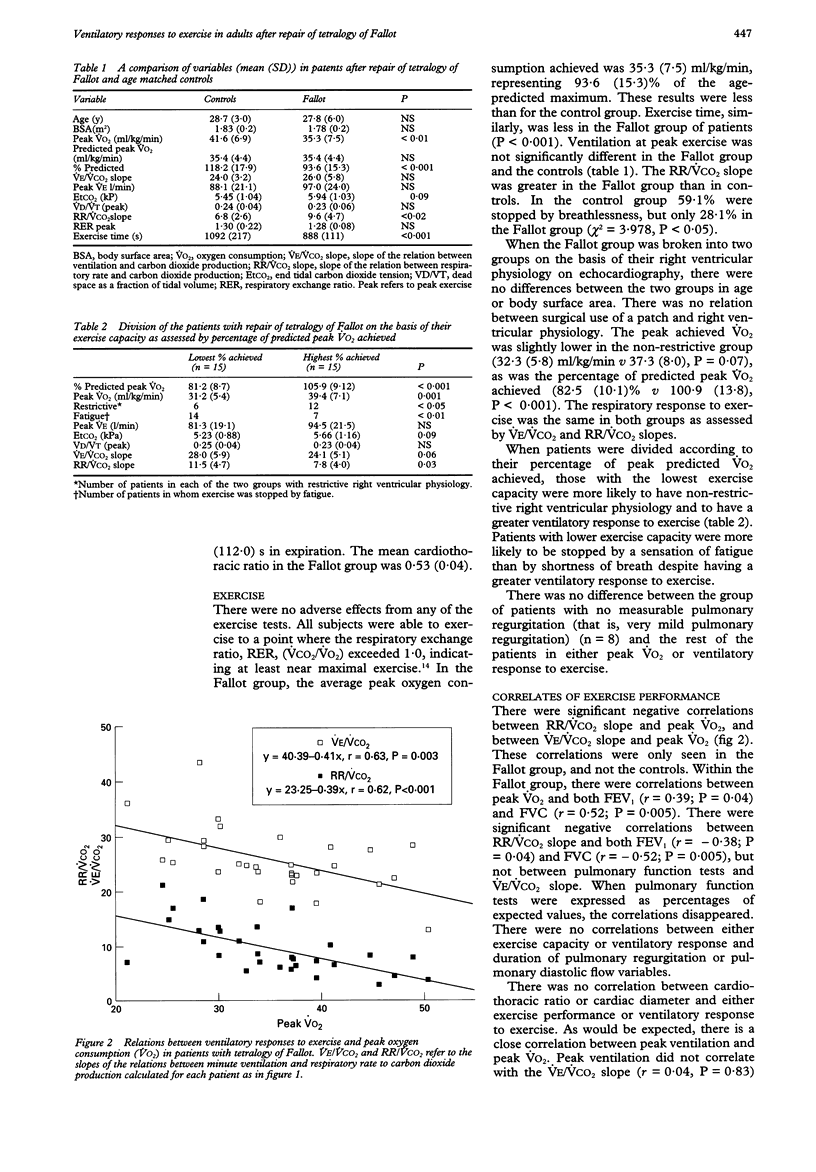
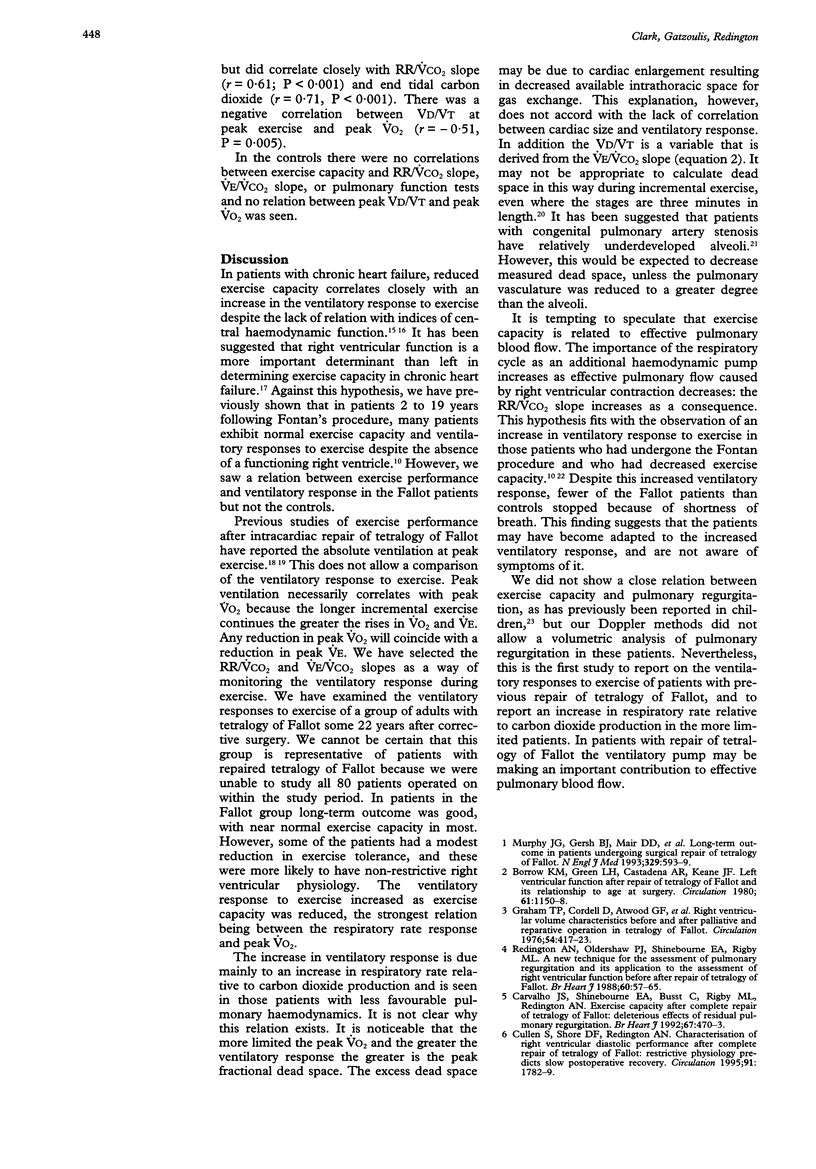
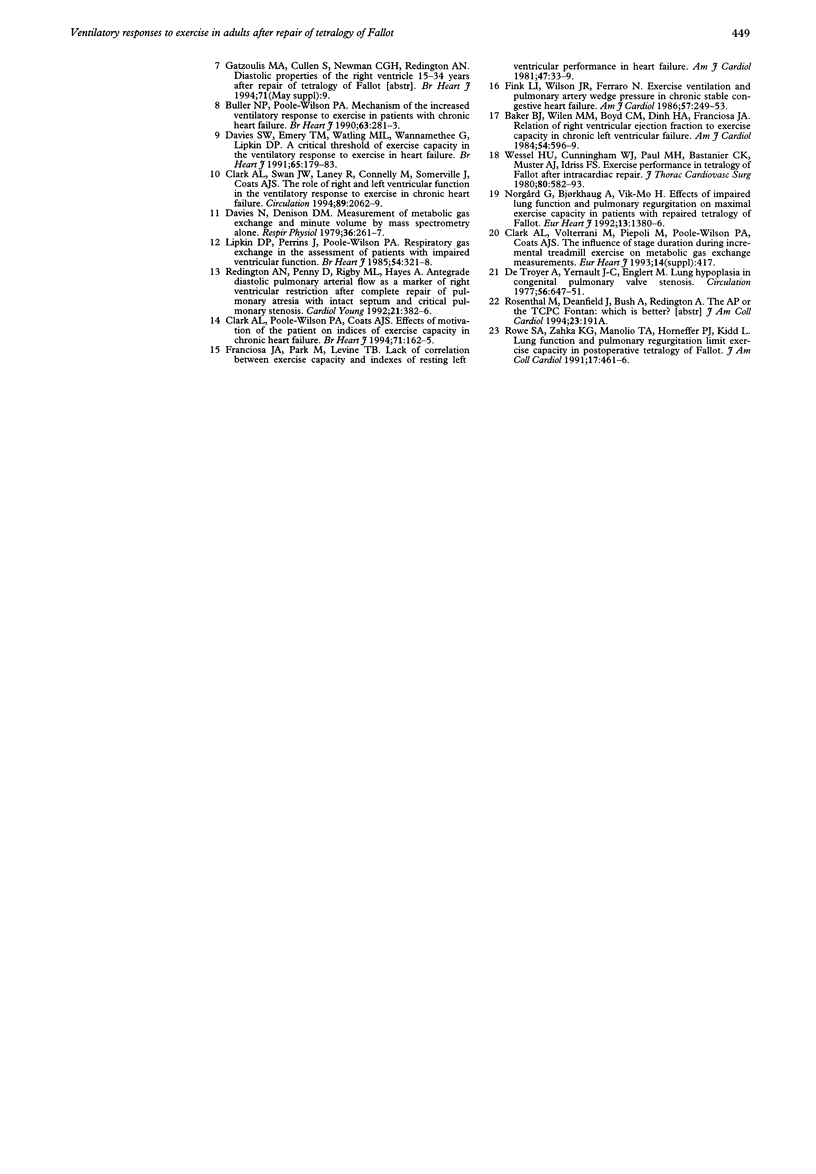
Selected References
These references are in PubMed. This may not be the complete list of references from this article.
- Baker B. J., Wilen M. M., Boyd C. M., Dinh H., Franciosa J. A. Relation of right ventricular ejection fraction to exercise capacity in chronic left ventricular failure. Am J Cardiol. 1984 Sep 1;54(6):596–599. doi: 10.1016/0002-9149(84)90256-x. [DOI] [PubMed] [Google Scholar]
- Borow K. M., Green L. H., Castaneda A. R., Keane J. F. Left ventricular function after repair of tetralogy of fallot and its relationship to age at surgery. Circulation. 1980 Jun;61(6):1150–1158. doi: 10.1161/01.cir.61.6.1150. [DOI] [PubMed] [Google Scholar]
- Buller N. P., Poole-Wilson P. A. Mechanism of the increased ventilatory response to exercise in patients with chronic heart failure. Br Heart J. 1990 May;63(5):281–283. doi: 10.1136/hrt.63.5.281. [DOI] [PMC free article] [PubMed] [Google Scholar]
- Carvalho J. S., Shinebourne E. A., Busst C., Rigby M. L., Redington A. N. Exercise capacity after complete repair of tetralogy of Fallot: deleterious effects of residual pulmonary regurgitation. Br Heart J. 1992 Jun;67(6):470–473. doi: 10.1136/hrt.67.6.470. [DOI] [PMC free article] [PubMed] [Google Scholar]
- Clark A. L., Poole-Wilson P. A., Coats A. J. Effects of motivation of the patient on indices of exercise capacity in chronic heart failure. Br Heart J. 1994 Feb;71(2):162–165. doi: 10.1136/hrt.71.2.162. [DOI] [PMC free article] [PubMed] [Google Scholar]
- Clark A. L., Swan J. W., Laney R., Connelly M., Somerville J., Coats A. J. The role of right and left ventricular function in the ventilatory response to exercise in chronic heart failure. Circulation. 1994 May;89(5):2062–2069. doi: 10.1161/01.cir.89.5.2062. [DOI] [PubMed] [Google Scholar]
- Cullen S., Shore D., Redington A. Characterization of right ventricular diastolic performance after complete repair of tetralogy of Fallot. Restrictive physiology predicts slow postoperative recovery. Circulation. 1995 Mar 15;91(6):1782–1789. doi: 10.1161/01.cir.91.6.1782. [DOI] [PubMed] [Google Scholar]
- Davies N. J., Denison D. M. The measurement of metabolic gas exchange and minute volume by mass spectrometry alone. Respir Physiol. 1979 Feb;36(2):261–267. doi: 10.1016/0034-5687(79)90029-x. [DOI] [PubMed] [Google Scholar]
- Davies S. W., Emery T. M., Watling M. I., Wannamethee G., Lipkin D. P. A critical threshold of exercise capacity in the ventilatory response to exercise in heart failure. Br Heart J. 1991 Apr;65(4):179–183. doi: 10.1136/hrt.65.4.179. [DOI] [PMC free article] [PubMed] [Google Scholar]
- De Troyer A., Yernault J. C., Englert M. Lung hypoplasia in congenital pulmonary valve stenosis. Circulation. 1977 Oct;56(4 Pt 1):647–651. doi: 10.1161/01.cir.56.4.647. [DOI] [PubMed] [Google Scholar]
- Fink L. I., Wilson J. R., Ferraro N. Exercise ventilation and pulmonary artery wedge pressure in chronic stable congestive heart failure. Am J Cardiol. 1986 Feb 1;57(4):249–253. doi: 10.1016/0002-9149(86)90900-8. [DOI] [PubMed] [Google Scholar]
- Franciosa J. A., Park M., Levine T. B. Lack of correlation between exercise capacity and indexes of resting left ventricular performance in heart failure. Am J Cardiol. 1981 Jan;47(1):33–39. doi: 10.1016/0002-9149(81)90286-1. [DOI] [PubMed] [Google Scholar]
- Graham T. P., Jr, Cordell D., Atwood G. F., Boucek R. J., Jr, Boerth R. C., Bender H. W., Nelson J. H., Vaughn W. K. Right ventricular volume characteristics before and after palliative and reparative operation in tetralogy of Fallot. Circulation. 1976 Sep;54(3):417–423. doi: 10.1161/01.cir.54.3.417. [DOI] [PubMed] [Google Scholar]
- Lipkin D. P., Perrins J., Poole-Wilson P. A. Respiratory gas exchange in the assessment of patients with impaired ventricular function. Br Heart J. 1985 Sep;54(3):321–328. doi: 10.1136/hrt.54.3.321. [DOI] [PMC free article] [PubMed] [Google Scholar]
- Murphy J. G., Gersh B. J., Mair D. D., Fuster V., McGoon M. D., Ilstrup D. M., McGoon D. C., Kirklin J. W., Danielson G. K. Long-term outcome in patients undergoing surgical repair of tetralogy of Fallot. N Engl J Med. 1993 Aug 26;329(9):593–599. doi: 10.1056/NEJM199308263290901. [DOI] [PubMed] [Google Scholar]
- Norgård G., Bjørkhaug A., Vik-Mo H. Effects of impaired lung function and pulmonary regurgitation on maximal exercise capacity in patients with repaired tetralogy of Fallot. Eur Heart J. 1992 Oct;13(10):1380–1386. doi: 10.1093/oxfordjournals.eurheartj.a060070. [DOI] [PubMed] [Google Scholar]
- Redington A. N., Oldershaw P. J., Shinebourne E. A., Rigby M. L. A new technique for the assessment of pulmonary regurgitation and its application to the assessment of right ventricular function before and after repair of tetralogy of Fallot. Br Heart J. 1988 Jul;60(1):57–65. doi: 10.1136/hrt.60.1.57. [DOI] [PMC free article] [PubMed] [Google Scholar]
- Wessel H. U., Cunningham W. J., Paul M. H., Bastanier C. K., Muster A. J., Idriss F. S. Exercise performance in tetralogy of Fallot after intracardiac repair. J Thorac Cardiovasc Surg. 1980 Oct;80(4):582–593. [PubMed] [Google Scholar]


